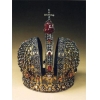|
 It is of no
doubt that any jewelry has its value. When the jewelry item is acknowledged the
popular work of art and it’s value increases relatively. The precious jewelry acquires
the invaluable status, especially when it has the traces of history and
religion upon it. First, such jewelry come as various crowns and diadems of
numerous monarchs, emperors, kings and rulers. It is of no
doubt that any jewelry has its value. When the jewelry item is acknowledged the
popular work of art and it’s value increases relatively. The precious jewelry acquires
the invaluable status, especially when it has the traces of history and
religion upon it. First, such jewelry come as various crowns and diadems of
numerous monarchs, emperors, kings and rulers.
The list of
remarkable and notable jewelry of royal regalia includes the Big Imperial Crown
of the Russian Federation
which is the cultural and historical heritage and the masterpiece of the art of
jewelry.
A small historical
excursion to the ancient Russia
will show that the autocrats were crowned with the special crowns, the most
known as Monomakh Crown. The real crowns close to European standards appeared in
Russia
during the reign of Peter I, when in 1724 the first crown was created for coronation
of the Imperial Lady, Catherine I, wife to the emperor. Consequently the crown was
remade few times to meet the requirements of the coming imperial authorities.
It happened until the very Big Imperial Crown was made in 1762
especially for the event of coronation of Catherine II. The Crown later was laid upon the
heads of all Russian rulers to the last royal person, Nikolay II.
The Big Imperial
Crown was created by the reputed jewelers Georg Friedrich Eckart and Jeremy Posier,
who were free to create anything they like providing that the crown should not
weigh over two kg. In a creative tandem, Eckart was responsible for preparation
of the drawings of the future item and the one who prepared the case for that.
Posier was charged to pick up the precious stones. The work was completed for
the record of two months to be estimated to 8200 Russian roubles. The association
between the two jewelers was not friendly and for the longer time Eckart was
believed to be the only author to the Crown who committed to hiding every
contribution of Posier in creation of this masterpiece.
The shape for
the Crown was adopted with the head wear used by the Eastern rulers.
Actually it
resembles the turban sultan would wear in India
rather than the traditional crown of the medieval Europe.
Two big hemispheres symbolized tow parts of the world, that is Europe
and Asia, West and East united in the borders of the Russian
Empire. Approximately five thousand (to be precise 4936) tiny diamonds
with the
total weight of 2858 carats are incrusted into these two big
hemispheres. Fifty
four tiny Indian pearls are also inserted into the crown, first for
coronation
of Paul I of Russia
with the seventy two pearls of smaller size at the reign of Catherine.
The biggest
and all-known precious stone of the Big Imperial Crown is the ruby, that is
spinel, mounted to the gold arch topped with the diamond cross weighing
approximately 400 carats. This stone of rich red color is the traditional
treasure to the Imperial House of the Romanovs. They acquired the stone almost a
century before the Big Crown was made, in 1676. The stone was purchases by the Russian
diplomats from Kangxi, the Emperor of China, and later it was the absolute part
of all crowns used for Royal persons during the coronation ceremonies.
This ruby
is the component to the mnemonic ensemble of the regalia of Russian emperors. A
gin stone of intensive red color was complemented with a blue sapphire set into
the orb and the brilliant diamond of white color set onto the sceptre. Therefore,
these three biggest precious stones symbolized colors of the state гflag of Russia in white, blue and red
colors. The Big Imperial Crown of Russian Empire was appropriately considered
the major treasure of the royal family and in the late XIX century the net
value of the jewelry without the symbolic historical value was estimated to a
million of gold roubles of Russia.
The replica of the Big Imperial Crown of smaller size was made by legendary
jeweler Faberge for the coronation ceremony of Nikolay II and his spouse
Aleksandra Fedorovna. The replica was named the Small Crown of Russian Empire which
afterwards appeared to be the subject of detective stories and movies.
Unlike the Small
Crown, the original Big Imperial Crown always stayed in territory of
Russia itis kept in the Diamond Fund. In the early 2009 the mass media
in America suggested an idea the Russia possessed a replica while the
authentic Big
Imperial Crown along with the other treasury by the Romanovs was buried
in the Goby
desert in Mongolia.
These assumptions are based upon the statements of Russian descendants
residing
in America,
though the historians found the statements unreasonable because of lack
of
documented evidences and the logical contradictions of the announced
version.
and in the period of post-revolution in 1917 it was found in treasury
of the
state.
Currently it is kept in the Diamond Fund.
In the early 2009 the mass media
in America suggested an idea
the Russia possessed a replica
while the authentic Big Imperial Crown along with the other treasury by the
Romanovs was buried in the Goby desert in Mongolia. These assumptions are based
upon the statements of Russian descendants residing in America, though
the historians found the statements unreasonable because of lack of documented
evidences and the logical contradictions of the announced version.
|